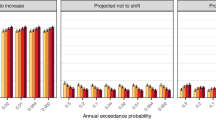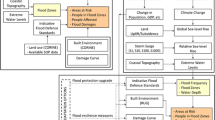Abstract
Urban flooding is often used as an illustration of the potentially adverse effects of greenhouse-induced climate change on extreme events. There is however, a paucity of studies that convert climate scenarios into changes in flood damage. This account summarises the use of modelling techniques, for three flood prone urban catchments in south eastern Australia, to assess changes to urban flood losses for the 'most wet' and 'most dry' scenarios for the year 2070. The most wet scenario indicates that annual average flood damage could increase within the range of 2.5 to 10 times, under the most dry scenario flood regimes would be similar to those experienced at present. The socio-economic scenarios based on the changes to flood losses are used to consider policy responses. It is unlikely that many local government authorities will respond because of lack of interest and because of major changes to the climate scenarios proposed over the last decade. Any response is likely to be incremental and accord with the 'no regrets' and the precautionary principle'.
Similar content being viewed by others
References
Bouma, W.J., Pearman G.I. and Manning, M.R.: 1996, (eds.), ‘Greenhouse: coping with climate change’, CSIRO Publishing, Melbourne.
Bruce, J.P., Lee, H. and Haites, E.F.: 1996, Climatic change 1995: economic and social dimensions to climatic change. (Working Group III, Second Assessment Report of IPCC), Cambridge University Press, Cambridge.
Carter, T.R., Parry, M.L., Harasawa, H. and Nishioka, S.: 1996, The IPCC technical guidelines for assessing climate change impacts and adaptations, University College London and Centre for Global Environmental Research, London.
CIG.: 1992, ‘Climate change scenarios for the Australian region (issued November 1992)’, Climate Impact Group, CSIRO Division of Atmospheric Research, Melbourne, 6 pp.
CIG.: 1996, ‘Climate change scenarios for the Australian region (issued November 1996)’. Climate Impact Group, CSIRO Division of Atmospheric Research, Melbourne, 8 pp.
Downing, T.E., Olsthoorn, A.A. and Tol, R.S.J.: (eds.), 1996, Climatic change and extreme events: altered risk, socio-economic impacts and policy responses., Vrije Universiteit, Amsterdam.
Fowler, A.M. and Hennessy, K.J.: 1995, ‘Potential impact of global warming on the frequency and magnitude of heavy precipitation’, Natural Hazards, 11, 283–303.
Houghton, J.T., Callender, B.A. and Varney, S.K.: (eds.), 1992, Climate change 1992: the supplementary report to the IPCC scientific assessment. Cambridge University Press, Cambridge.
Houghton, J.T., Meira Filho, L.G., Callender, B.A., Harris, N., Kattenberg, A. and Maskell, N.: (eds.), 1996, Climate change 1995: the science of climate change. Cambridge University Press, Cambridge.
May, P.J., Burby, R.J., Ericksen, N.J., Handmer, J.W., Dixon, J.E., Michaels, S. and Smith, D.I.: 1996, Environmental management and governance: intergovernmental approaches to hazards and sustainability, Routledge, London, pp. 254.
Minnery, J.R. and Smith, D.I.: 1996, ‘Climatic change, flooding and urban infrastructure’. In. Bouma, W.J., Pearman, G. I. and Manning, M.R.: (eds.), Greenhouse: coping with climate change, CSIRO Publishing, Melbourne, pp. 235–247.
NSW.: 1996, Floodplain Development Manual. Report prepared by Public Works Department of New South Wales. PWD Report No. 86010. Public Works Department: Sydney.
Pearman, G.I.: (ed.), 1988, ‘Greenhouse: planning for climate change.’ CSIRO Division of Atmospheric Research, Melbourne.
Penning-Rowsell, E.C., Handmer, J. and Tapsell, S.: 1996, ‘Extreme events and climate change: floods.’ In. Downing, T.E., Olsthoorn, A.A. and Tol, R.S.J.: (eds.), Climate change and extreme events: altered risk, socio-economic impacts and policy responses, Vrije Universiteit, Amsterdam, pp. 97–127.
Robinson, D.K.: 1988, Greenhouse-its impact on Australian hydrology: possible changes to flooding regimes. In: Pearman, G.I. (ed.), ‘Greenhouse planning for climatic change,’ Division of Atmospheric Research, CSIRO, Melbourne, pp. 261–272.
Smith, D.I.: 1993, ‘Greenhouse climatic change and flood damages-the implications’, Climate Change, 25, 319–333.
Smith, D.I.: 1996, ‘Flooding in Australia: Progress to the present and possibilities for the future’, Paper presented to the Conference on Natural Disaster Reduction 1996, Surfers Paradise, 29 September-2 October 1996, Heathcote, R.L., Cuttler, C. and Koetz, J. (eds.), pp. 11–22.
Smith, D.I.: 1996, National and State residential flood damages for Australia, Prepared for Insurance Council of Australia, 83 pp.
Smith, D.I., Handmer, J.W., McKay, J.M., Switzer, M.A.D. and Williams, B.J.: 1996, Issues in floodplain management: a discussion paper, National Landcare Program, Department of Primary Industries and Energy, Canberra, 2 vols.
Smith, D.I., Schreider, S. Yu, Jakeman, A.J., Zerger, A., Bates, B.C. and Charles, S.P.: 1998, ‘Urban flooding and greenhouse-induced impacts-methodology and case studies’, Resource and Environmental Studies, No. 17, Centre for Resource and Environmental Studies, Australian National University, Canberra, 68p.
Zehner, R.B.: 1991, ‘Environmental priorities and the greenhouse: planning at the local government level’, Australian Planner, 29(1), 33–38.
Author information
Authors and Affiliations
Rights and permissions
About this article
Cite this article
Smith, D. Urban Flood Damage and Greenhouse Scenarios - The Implications for Policy: An Example from Australia. Mitigation and Adaptation Strategies for Global Change 4, 331–342 (1999). https://doi.org/10.1023/A:1009623925591
Issue Date:
DOI: https://doi.org/10.1023/A:1009623925591




